In today’s world, a well manicured lawn is often seen as a sign of status. It doesn’t matter who you are or where you’re from; outsiders tend to look at your patch of green and judge you based on its condition.
Sometimes though, lawns can become damaged and discolored unexpectedly. They can develop burns or shredding and either turn white or stop growing altogether.
Da you wonder why is my grass turning white?
Well, generally grass turns white due to succumbing to several different stressors. It may suffer from a disease, drought, or even fertilizer burn. Whatever the case, the issue is usually fixable.
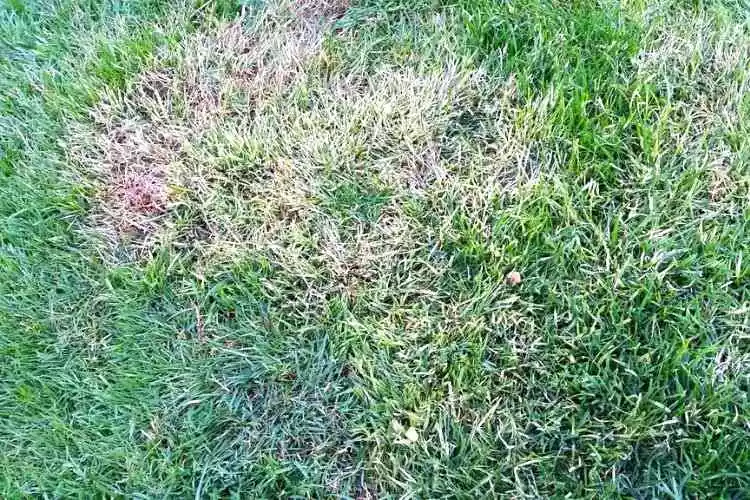
That is, of course, as long as it is spotted early enough and treated accordingly. In this article, we’ll go through the warning signs, the reasons for grass turning white, and some solutions to correct the issue. Let’s dig in, shall we?
Table of Contents
How to Notice The Signs of White Grass?
White grass is fairly easy to spot. You will first notice that the patch’s color is fading out from its darker, healthier greens into more gray or white shades.
Besides the obvious discoloring, closer investigations of the grass blades can reveal a change in their appearance and characteristics.
Depending on the cause, they can form burn spots or patching, they may seem covered in a flour-like substance, they can become much thinner and weaker, or they may even dry out completely and die. If left untreated, the more severe cases can spread to other areas and damage them further.
Why is my grass turning white? (The Best Guide)
If your lawn is slowly fading into a whitish color, alarm bells should start ringing. It usually means that it is subject to certain stressors. These stressors can include specific diseases, side effects of herbicides, drought, etc.
Whatever the case, the grass could be suffering. Let’s look at all the different reasons that can make grass turn white in detail.
Due to Diseases
There are a few different diseases that can cause the whitening of a lawn. The most common include:
Powdery Mildew
Diseases such as powdery mildew will initially present white-like spores on each blade. As the problem advances, the affected area can almost look like it is blanketed in a white, powdery, or chalky substance.
Some people even say it looks like their grass patch has been painted.
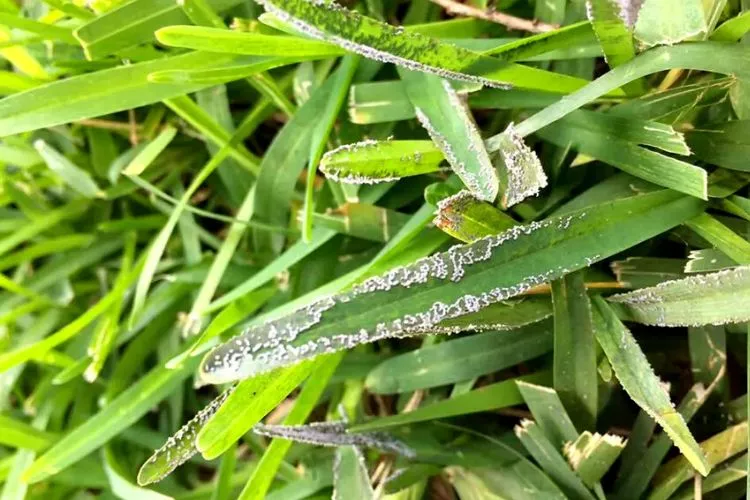
Powdery Mildew is more of a patch disease and rarely covers a whole lawn. It is usually caused by a lack of air circulation and high humidity.
Commonly infected areas are usually those that are heavily shaded. These may include under larger trees, next to retaining walls and buildings, and also along panel fence linings.
The amount of the contracted disease heavily relies on the grass’s location and environment. It affects more cool season grasses such as Kentucky bluegrass, fescues, and perennial rye grasses. Powdery Mildew infections are usually mild and can be treated without causing negative effects.
Gray Leaf Spot
Gray Leaf spot is found more on newly established grass areas. During this period, it can damage entire lawns. As the grass matures, the effect of the disease slowly becomes less severe until the grass is strong enough to tolerate it.

It starts as tan or brown spots on the leaves; then, as humidity rises or moisture increases, the color fades into more of a gray shade. It is most common on St. Augustine grass but can also be spotted on tall fescue, bermuda grass, centipede grass, and ryegrass in home lawns.
Fusarium patch and Fusarium blight
The spreading of fungi causes Fusarium blight and its patchingi. It generally affects older or finer turf. You’ll notice smaller circles of gray/green patches in the beginning. They can be a few inches or even a foot in diameter. Stronger plants can survive inside the patches, which causes a donut-like appearance.
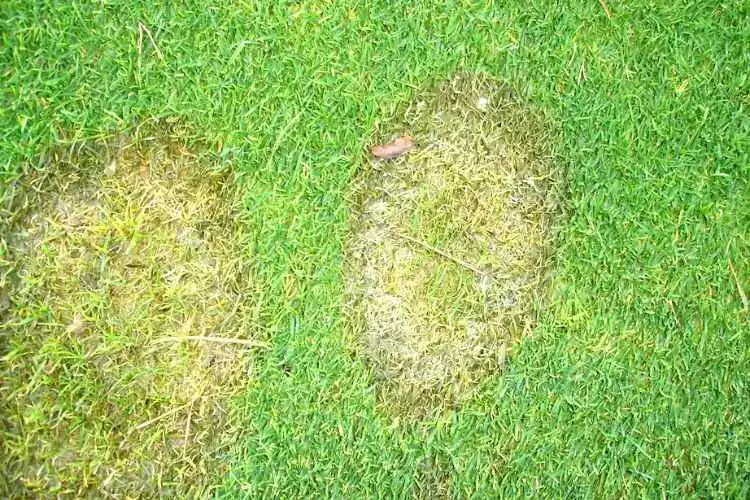
Often, Fusarium blight is untreatable and eventually dries grass out completely, killing larger areas. High humidity, poor lighting, and inadequate air circulation contribute to this disease’s strength and spread rate.
The most commonly affected grass species include bentgrasses, red fescue, tall fescue, perennial ryegrass and centipedegrass, and Kentucky bluegrass.
Gray Snow Mold
Gray Snow Mold (a.k.a. Typhula blight) generally occurs under snow cover later in the winter to early in the spring. Once the snow melts away, you will generally notice circles or irregular patches up to 3 feet or more in diameter.
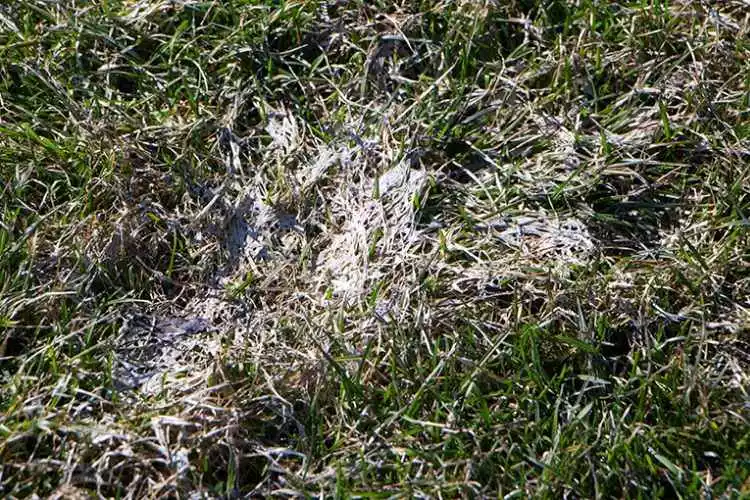
The grass within these patches will appear white or gray, brittle and matted. The affected grass will appear web due to the mycelium coverage.
Most cool season grasses are susceptible to this disease. The hardest hit is usually creeping bent grass, annual blue grass, tall fescue, and perennial ryegrass.
Due to Herbicide Side Effects
Herbicides are designed to kill off the weeds, leaving plants without competition for nutrients, water, sun, etc. However, sometimes the amount of herbicide administered can become unbalanced, causing bleaching, which will leave a lawn looking white.
Furthermore, the organic compound, Mesotrione, which is used in many herbicides,, can cause heavy bleaching. This compound blocks the enzymes that are responsible for the production of chlorophyll.
The lack of chlorophyll won’t allow the grass to produce deep green colors and instead turn grayish white.
Due to Damage Caused by a Lawn Mower
Mowing a lawn is a common task that keeps it maintained and fresh looking. However, when a grass area is cut too often, and at really low levels, it doesn’t allow the grass to photosynthesize as it usually would. It cannot regenerate itself, making it harder to grow back and fade in color.
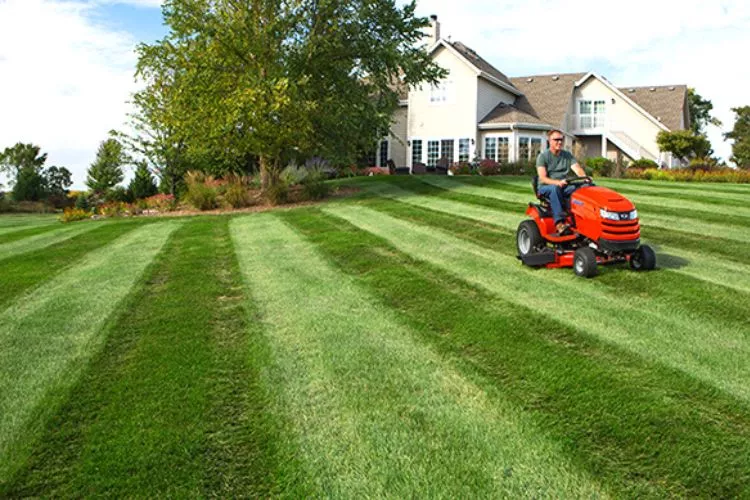
You could almost see it as the grass way of ‘waving the white flag,’ so to speak. So as much as we like to keep our grass well kept, sometimes it needs the chance to breathe and grow, or else it will dry out and die.
Due to Drought
Grass needs water to enable it to germinate in the case of fresh grass being sown. Then, of course, water assists grass in general growth. When the moisture supply is restricted, the grass won’t be able to photosynthesize. Water is a key aspect of utilizing the photosynthesis process.
Grass uses hydrogen from the water content, which is absorbed into its root system and releases oxygen as a byproduct. So if drought is present, the growth of the grass will become stunted as it dries out and has a white, faded appearance.
Due to Fertilizer Burn
Fertilizers have a high mineral salt content which sucks all the moisture out of the plants and even the soil. It dehydrates all plants if not administered correctly.

Even in the correct doses, it can still produce white stripes and spots as it burns into the grass. If left untreated, the stripes and spots can lead to complete discoloration. This is where you may notice a lawn having a bleached like appearance.
Due to Soil deficiencies
When the soil in which grass is grown lacks iron, it can stress the grass as it searches for replacement stores. This process makes the grass fade into a light green to white color.
Quite often, we try to add other minerals to the soil to balance the deficiency and have even more of a negative effect in doing so. It’s always best to test the soil and create a plan to assist in regenerating minerals over a long period. This will reduce shock and, of course, discoloration.
How do you fix a sick lawn?
Once your grass turns white, the first reaction always seems to be panic. However, a lot of these issues can be corrected. All that matters is that they are discovered early enough to be able to do something about them.
If you notice that your lawn suffers from one or multiple causes mentioned in the previous section, then have no fear.
Right now, we’re going to have a detailed look into all the things you can do to mitigate these problems and turn them around once they occur. Let’s get into how you can fix a sick looking lawn.
Examine Your Soil Properly
The first step to rejuvenating any lawn is to have the soil tested. Samples are sent to a laboratory, and the soil is tested for a range of things that all point back to its overall quality.

The results will indicate where it sits on the pH scale if there are any mineral deficiencies, what the hydration levels look like, etc. With this information, you can decide what further action to take to fix any lawn issues you may have.
Apply a High Quality fungicide
Fungicides are designed to assist in the eradication of fungal type diseases. If your lawn has discolored due to powdery mildew,, then a decent quality fungicide can help lessen or even resolve the issue. There are a couple of good quality natural products that can help fight powdery mildew.
These include sulfur, neem oil, and triforine. Remember that sulfur can be toxic to humans and pets, so it must be used carefully. Alternatively, you can use the common household product Baking soda (potassium bicarbonate) with light horticultural oils to create a safer, non-toxic substitute.
Better Your Mowing Practices
One of the best possible tips to live by when trying to grow strong, healthy grass is always leaving ⅓ of the blades when mowing. This may seem a little pedantic, but allowing the grass to photosynthesize will help it to produce the food it requires and, in turn, lush green beauty.
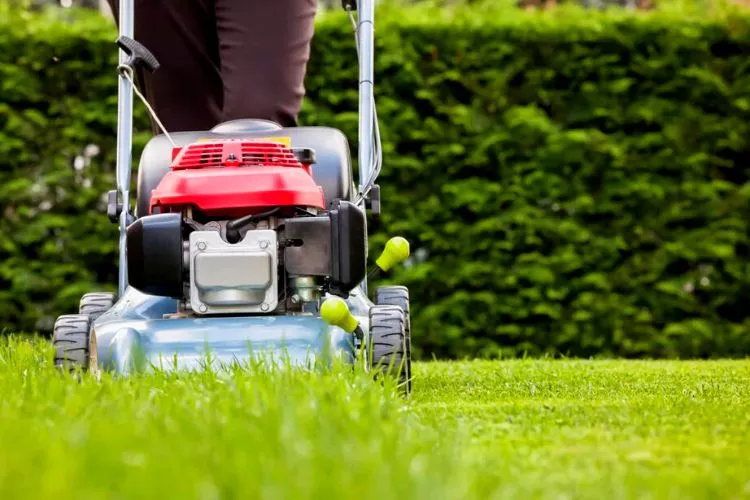
Another thing to consider when using a lawn mower is the condition of its blades. It’s common to avoid maintenance with something we only use now and then. The reality is that blunt lawn mower blades can cause more damage by not cutting as precisely as possible.
The constant hacking of grasses and weeds will contribute to wear and tear. Lawn mower blades should be sharpened every 20-25 hours and completely changed over every 2 seasons to ensure their longevity.
Use a High-Quality Fertilizer
Most common grass fertilizers are high in nitrogen. This is all well and good for improving color and strength, but the nitrogen can often ‘steal’ the availability of intake from other important nutrients. This can have a negative effect.
Furthermore, it is an inhibitor of powdery mildew and snow mold growth. It’s a good idea to switch it up and choose a high quality alternative or even a more organic variant that can reduce the risk of inviting fungal diseases.
Apply a slow-release fertilizer evenly
Some fertilizers work so fast that they burn the grass and fade its color out to more of a grayish-white shade. Furthermore, it can get a little tricky with overlapping and missed spots.
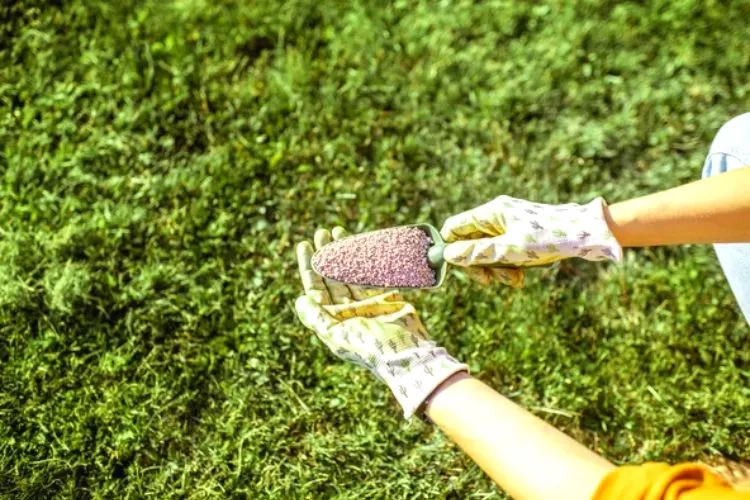
You can also cause negative outcomes when doing so. Using slow-release fertilizers is a lot easier to control and distribute evenly. Instead of blasting the grass with chemicals, they react to weather and ground conditions which also help the process considerably.
Dethatch the lawn
Dethatching your lawn will help to encourage more sunlight as well as regenerate the soil, so the minerals become more available for growth. Dethatching efficiently removes surplus amounts of thatch (the over layer of dead grass, debris, and other organic matter that sits nestled between the grass blades and the soil’s surface).
This method will allow your lawn access to the nutrients, air, and water it had previously been missing out on. The deficiency of these elements alone can contribute to lawn discoloration. Dethatching is a powerful, deep lawn raking that shouldn’t be looked past to improve the overall condition of a lawn.
Add Proper Sunlight Exposure
Removing branches or tree canopies that block sunlight can help rejuvenate your lawn. Fungal diseases thrive in low light, poor air, and high humidity areas. So opening these trouble spots up to light and air can ward off white, causing powdery mildew. Additionally, more light means better quality photosynthesis, producing a healthy, green lawn.
Aerate Your Lawn
If your lawn is fading due to starvation from nutrients, air, and moisture, it may be that your soil is much too compact to take these vital elements in.
Aerating your lawn is performed by perforating the soil surface, giving the grass much needed access to nutrients, air, and moisture.
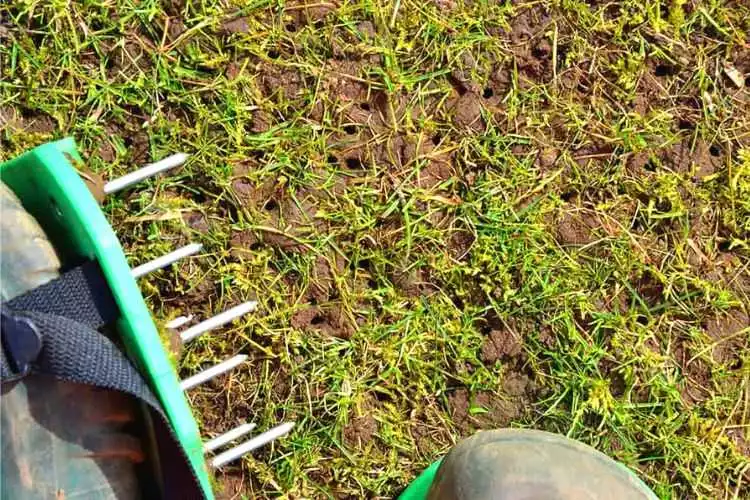
You can purchase specifically designed shoes with spikes to manually perforate the surface or hire machinery to do the job for you. It all comes down to personal preference about time and budget.
Get Rid of Weeds and Unwanted Insects
Weeds and insects will degrade the quality of your lawn, leaving it dull and faded if left unattended. It’s recommended to use a high quality organic herbicide for the weeds and insecticide for the insects and bugs.
Remember that pollinators use the grass as a freeway when doing business, so it’s best to choose times when they are not out, helping to assist in plant growth.
Grow the Grass a Bit Taller
When the faded color becomes a problem, sometimes the best solution is the simplest. Let your grass grow that little bit extra before cutting. And when you do cut, cut it slightly longer than you normally would.
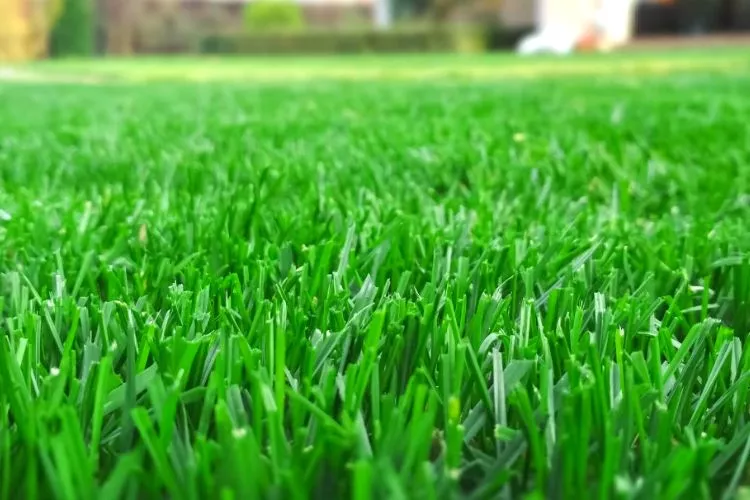
You’ll be surprised at how much additional photosynthesis the grass can perform with that extra height. The blades reach toward the sun and convert those sweet rays into usable energy. Leaving them lush and green as a result.
Dispose of Clippings Carefully
Suppose you are cutting grass that has been affected by any fungal disease. In that case, it’s recommended to discard the clippings well away from any other organic matter, including grass, plants, trees, bushes, compost, etc.
This will prevent any spread of disease. However, if the grass is clean and healthy, there is nothing better than redistributing the grass’s minerals back into the cut lawn. It will only improve the strength and overall appearance.
Reseeding
After treating any fungal disease or burns, you may need to consider reseeding to replace damaged grass areas. This is usually best done in the early fall when there is still a bit of warmth left in the soil to help germination.
Otherwise, mid to late spring can also boost grass germination as the season gets slightly warmer.
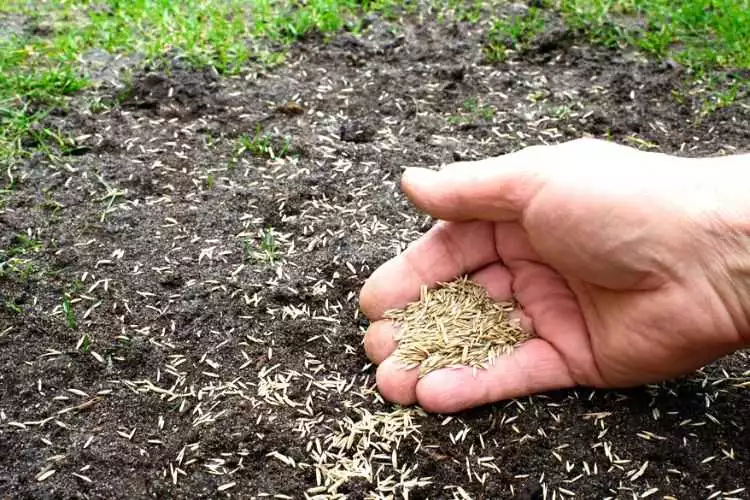
Choose good quality seeds, and remove any decaying grass and all weeds. Sow seeds and rake in evenly. You may need to apply a light layer of seeding soil to keep the seeds insulated. Aeration must also be assessed, especially when showing a heavily compacted patch of soil.
Adjust the soil pH
Alkaline soils are low in iron, and iron deficiencies can cause fading in the grass. Ideally, you want to try to correct the pH to around 6.5 to 7 levels (slightly acidic). You can add iron sulfate, elemental sulfur, sphagnum peat, and/or top dress the soil with an organic mix. All of these additives will help lower and stabilize your soil’s pH.
Proper Watering Schedule
A good quality lawn requires a lot of moisture, especially in the beginning and during germination. Aim to soak the lawn down to around 1-1.5 inches. Increase the frequency during the drier summer months for best results.
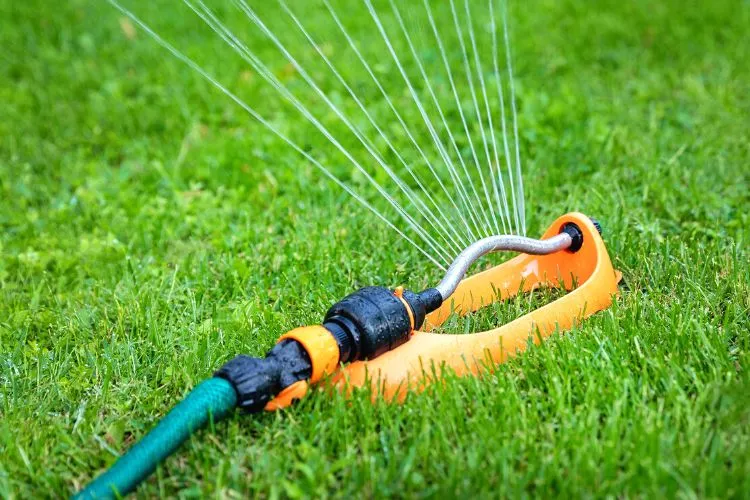
Don’t forget to encourage aeration. This factor alone will allow more moisture to get down into the roots of the grass, in turn allowing the photosynthesis process to produce lush green blades.
Frequently Asked Questions (FAQs)
Can white grass turn green again?
It all depends on what turned the grass white in the first place. Severe burns can destroy it soon after the faded white color disappears. At the same time, fungal issues are more treatable with fungicides and some extra TLC.
Does white grass grow back?
White grass can grow back as long as whatever caused it to turn white didn’t get down to the roots and kill it. Dead grass cannot be revived. However, damaged grass can.
Will lawn fungus go away on its own?
It is possible to make some changes in the surrounding area to create an environment where the fungus cannot thrive. For example, powdery mildew thrives in areas with low light, high humidity, and poor air circulation.
So removing sheltering foliage, such as bushes, branches, tree canopies, etc., can improve the conditions and kill off the fungus. Otherwise, fungicides are your next option.
How long does grass stay white after tenacity?
The symptoms can appear around 5-7 days after application and last several weeks before subsiding.
Conclusion:
As we have just discovered, there are many reasons your grass can turn white. Whether it’s via burning, mineral deficiency, or fungal disease, there is hope to treat the problem.
As long as it hasn’t gone past the point of no return, making a few simple tweaks can help turn a faded patch of grass into the lush green glory it once was.
We hope this article has been helpful, and we look forward to seeing you next. As always, happy growing!


